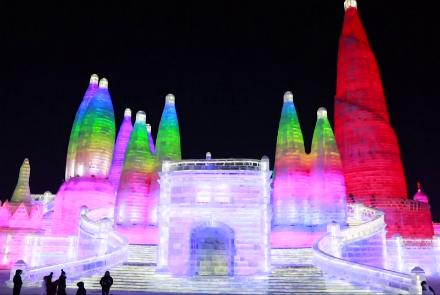The 2018 edition of the Harbin International Ice and Snow Sculpture Festival, the world's largest, has attracted many tourists with its intricate frozen works of art since it opened on December 24 in China.
Braving freezing temperatures, many visitors from far and wide have come to see the sculptures lit up with LED lights. Works included national landmarks, frozen palaces, ice slides and snow cherubs.
"I'm from Yemen. This is my first time here in Harbin, and the Ice City Festival," said an exchange student Ahmed Manswor. There is no place else like Harbin in winter, he said.
Christina Phipps, a tourist from the United States, came to visit along with her husband and children. They were deeply impressed by the "incredible" Buddhist structure and the castles.
"Just the work that's gone into [making the sculptures], the amount of manpower that's gone into it and getting it all together. It's just amazing!" she said.
The festival this year incorporated the concept of the Belt and Road Initiative into its design, showcasing the most iconic architecture from countries involved in the project.
"We hope to present to the visitors the concept of the Belt and Road Initiative with ice and snow," said Wang Zengyu, the deputy general manager of the Harbin Ice and Snow World.
A record of 180,000 cubic meters of ice has been used this year to recreate some of the most famous landmarks around the world, such as Beijing's Temple of Heaven, Moscow's Red Square, and Thailand's Wat Phra Kaew.
More than 10,000 staff have been involved in constructing the exhibits, including Du Yanjiang, who has been carving ice for two decades.
"The Songhua River produces a large area of ice due to the freezing temperatures every year. The ice we use is all from the nearby Songhua River. Other rivers are not able to produce as much ice and the water is not as clear [as that of the Songhua River]. An exhibition of such scale has experienced a lot of modernization. Large machinery has replaced a lot of the manual labor," said Du.
This year's festival is expected to run until Feb 25, 2018.

